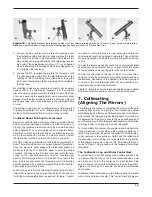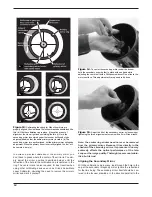
tions on sight, consult a planisphere. The planisphere gives
an all-sky view and shows which constellations are visible on
a given night at a given time.
Now, look at your star chart and find the brightest star in the
constellation that is near the object you are trying to find.
Using the finder scope, point the telescope at this star and
center it on the crosshairs. Next, look again at the star chart
and find another suitably bright star near the bright star cur-
rently centered in the finder. Keep in mind that the field of view
of the finder scope is approximately 7°, so you should choose
another star that is no more that 7° from the first star, if possi-
ble. Move the telescope slightly, until the telescope is cen-
tered on the new star.
Continue using stars as guideposts in this way until you are at
the approximate position of the object you are trying to find
(Figure 20). Look in the telescope’s eyepiece, and the object
should be somewhere within the field of view. If it’s not, sweep
the telescope carefully around the immediate vicinity until the
object is found.
If you have trouble finding the object, start the starhop again
from the brightest star near the object you wish to view. This
time, be sure the stars indicated on the star chart are in fact
the stars you are centering in the eyepiece. Remember, the
finder scope (and main telescope eyepiece, for that matter)
gives an inverted image, so you must keep this in mind when
starhopping from star to star.
9. Care and Maintenance
If you give your telescope reasonable care, it will last a life-
time. Store it in a clean, dry, dust-free place, safe from rapid
changes in temperature and humidity. Do not store the tele-
scope outdoors, although storage in a garage or shed is OK.
Small components like eyepieces and other accessories
should be kept in a protective box or storage case. Keep the
dust cover on the front of the telescope when not in use.
Your SkyView Pro 6LT EQ requires very little mechanical
maintenance. The optical tube is steel and has a smooth
painted finish that is fairly scratch-resistant. If a scratch does
appear on the tube, it will not harm the telescope. Smudges
on the tube can be wiped off with a soft cloth and a household
cleaner such as Windex or Formula 409.
Cleaning Lenses
Any quality optical lens cleaning tissue and optical lens clean-
ing fluid specifically designed for multi-coated optics can be
used to clean the exposed lenses of your eyepieces or finder
scope. Never use regular glass cleaner or cleaning fluid
designed for eyeglasses. Before cleaning with fluid and tis-
sue, however, blow any loose particles off the lens with a
blower bulb or compressed air. Then apply some cleaning
fluid to a tissue, never directly on the optics. Wipe the lens
gently in a circular motion, then remove any excess fluid with
a fresh lens tissue. Oily fingerprints and smudges may be
removed using this method. Use caution; rubbing too hard
may scratch the lens. On larger lenses, clean only a small
area at a time, using a fresh lens tissue on each area. Never
reuse tissues.
Cleaning Mirrors
You should not have to clean the telescope’s mirrors very
often; normally once every year or so. Covering the telescope
with the dust cover when it is not in use will prevent dust from
accumulating on the mirrors. Improper cleaning can scratch
mirror coatings, so the fewer times you have to clean the mir-
rors, the better. Small specks of dust or flecks of paint have
virtually no effect on the visual performance of the telescope.
The large primary mirror and the elliptical secondary mirror of
your telescope are front-surface aluminized and over-coated
with hard silicon dioxide, which prevents the aluminum from
oxidizing. These coatings normally last through many years of
use before requiring re-coating (which is easily done).
To clean the secondary mirror, first remove it from the tele-
scope. Do this by holding the secondary mirror holder station-
ary while turning the center Phillips-head screw. Be careful,
there is a spring between the secondary mirror holder and the
Philips-head screw; be sure that it will not fall into the optical
tube and hit the primary mirror. Handle the mirror by its hold-
er; do not touch the mirror surface. Then follow the same pro-
cedure described below for cleaning the primary mirror. You
do not need to remove the secondary mirror from its holder
when cleaning.
To clean the primary mirror, carefully remove the mirror cell
from the telescope. For the SkyView Pro 6LT EQ, this means
you must loosen the four screws on the tube near the primary
mirror cell. You do not need to remove the collimation screws
on the bottom of the mirror cell. Remove the mirror cell from
the tube. You will notice the primary mirror is held down with
three clips held by two screws each. Loosen the screws and
remove the clips.
You may now remove the mirror from the mirror cell. Do not
touch the surface of the mirror with your fingers. Lift the mirror
carefully by the edges. Set the mirror on a clean soft towel. Fill
a clean sink free of abrasive cleanser, with room-temperature
water, a few drops of liquid dishwashing detergent, and if pos-
sible, a capfull of rubbing alcohol. Submerge the mirror (alu-
minized face up) in the water and let it soak for a few minutes
(or hours if it’s a very dirty mirror). Wipe the mirror under water
with clean cotton balls, using extremely light pressure and
stroking in straight line across the mirror. Use one ball for
each wipe across the mirror. Then rinse the mirror under a
stream of lukewarm water. Any particles on the surface can
be swabbed gently with a series of cotton balls, each used
just one time. Dry the mirror in a stream of air (a “blower bulb”
works great), or remove any stray drops of water with the cor-
ner of a paper towel. Water will run off a clean surface. Cover
the mirror surface with Kleenex, and leave the mirror in a
warm area until it is completely dry before reassembling the
telescope.
17
Summary of Contents for SKYVIEW PRO 6LT EQ 9872
Page 19: ...19 ...






























